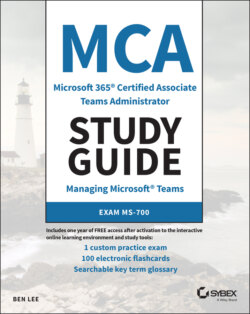Читать книгу MCA Microsoft 365 Teams Administrator Study Guide - Ben Lee - Страница 17
Building Knowledge Chapter by Chapter
ОглавлениеThe chapters in this book are not directly lined up with the MS-700 objectives but are instead laid out in what I would argue is a more logical manner that fits better with how you would actually deploy Teams.
Each chapter starts with an introduction that includes which sections are going to be covered in the chapter, but you can also refer to the table in the “MS-700 Objectives” section later in this introduction.
The following is a breakdown of what we will be covering together in each chapter:
Chapter 1, “Introducing Teams”: This chapter covers an overview of what Teams is and the core concepts behind it and how that fits with the wider Office 365 and Microsoft 365 offerings. It will also introduce some of the core concepts you will need to understand about how Teams is configured and managed.
Chapter 2, “Getting Teams Up and Running”: This chapter covers three main areas: Skype for Business migrations, network preparation, and client deployments. This chapter helps lay the foundations of understanding how Teams interacts with Skype for Business if you have it deployed and need to migrate away from it. It covers how to best prepare your network for dealing with Teams (mostly) media traffic and how to get the Teams client out to your end users and on your devices.
Chapter 3, “Teams Core Functionality”: This chapter covers Teams bread-and-butter tasks such as different types of teams, how to manage basic policies, how to control access to your Teams, and how to manage meetings.
Chapter 4, “Advanced Teams Functionality and Management”: This chapter covers how to apply security and governance against your Teams deployment and how to make sure your data is safe, secure, and available only to the people who need it. We will also look at things such as templates and app policies.
Chapter 5, “Adding Telephony”: This chapter covers how to incorporate PSTN calling into Teams, the different ways this can be delivered, and how this functionality works.
Chapter 6, “Review Usage and Maintain Quality”: It is all very well having Teams deployed and all your users enabled and configured, but you should also be proactively looking at how they are performing. This chapter will cover some of the tools you need to monitor usage and track down issues.
